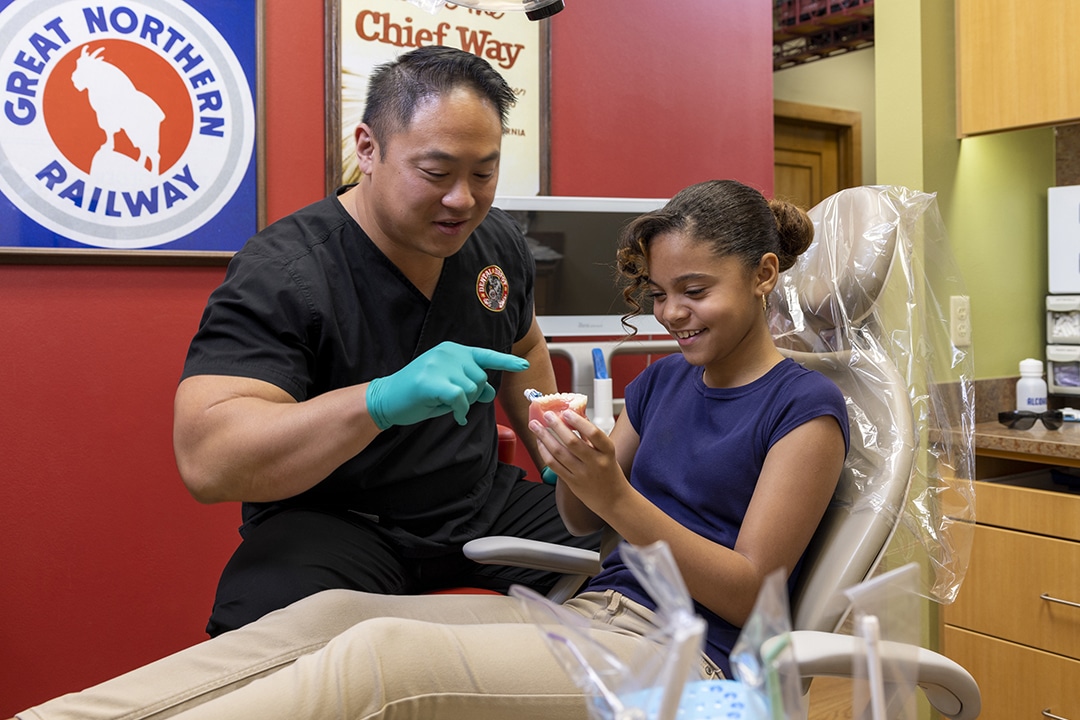Schedule Orthodontic Consultation
Braces, Invisalign, Retainers
Braces, Invisalign, Retainers
Orthodontic treatment uses appliances and pressure to gradually move teeth, guide jaw position, and retrain muscles for a straighter, healthier bite. Thanks to technological advancements, treatment options have evolved to perform the same physiological function with less pain and discomfort, lower cost, and faster results. The primary differences in treatments lies in the type and amount of hardware necessary for the appliance to achieve the desired result.

Smaller and sleeker than those of past generations, today’s braces use brackets, bands, and/or wires to gradually move teeth into place. Braces are effective even for severe cases and are generally the least expensive. Success with braces depends heavily on proper oral hygiene and routine office visits to adjust the braces as necessary.
Ceramic braces also use the same components of metal braces but the brackets are made of tooth-colored ceramic or porcelain instead of stainless steel, making them nearly invisible.
Instead of ligatures, self-ligating braces are aligned using a door mechanism. Because the braces slide along the wire instead of being held in place by rubber bands, teeth can move more freely with less discomfort and force. Self-ligating braces cause less friction between the wire and braces and are generally easier to maintain and care for. Without the need to replace rubber bands, appointment times can also be extended to 8-12 weeks.
Lingual braces have the same components as traditional metal braces, but they are affixed to the back of the teeth instead of the front. While traditional braces use a wire bent in a horseshoe shape, the wire on lingual braces can be custom fitted to the contours of your mouth, potentially shortening treatment. Because lingual braces are attached to the back of your teeth, where your tongue hits when you speak, you may experience a temporary lisp or interference with your speech when you first start treatment.
Clear aligner trays, such as Invisalign®, use a series of custom-made plastic trays to move the teeth. Aligners must be worn at least 20 hours per day and are switched every two weeks or so to help slowly reshape teeth. Compliance is key to success with clear aligners. The impermanence of the device requires patients to adhere strictly to their orthodontist’s guidance.
Severe malocclusions (misalignment of the top and bottom teeth) may require a two-phased approach, beginning with an appliance to shift the jaw and followed by orthodontic treatment to realign the teeth. Orthopedic jaw correction is typically performed when the jaw is still growing in childhood but can be used at any age to realign the jaw and prevent future problems.
The type or brand of treatment (whether braces, aligners, etc.) is not as important as the application of the treatment by a qualified orthodontist. After completing dental school, orthodontists are required to have an additional 2-3 years of orthodontics residency training to ensure they gain the experience and skill necessary for a healthy smile and bite. Orthodontists certified by the American Association of Orthodontists (AAO) specialize in moving teeth and aligning jaws and have the medical knowledge and insight to ensure treatments are applied correctly and safely.
Orthodontic treatments aren’t what they used to be. Dental Depot is proud to offer the latest in advanced orthodontic treatment options that provide quicker, gentler results with less pain and discomfort. Unlike other dental offices, we are more than routine cleanings and care, providing an AAO-certified orthodontist on staff at our Oklahoma City metro orthodontic locations.
For more information on orthodontic treatment, or to schedule a complimentary consultation with one of our orthodontists, visit our website to find an Orthodontic office near you.
